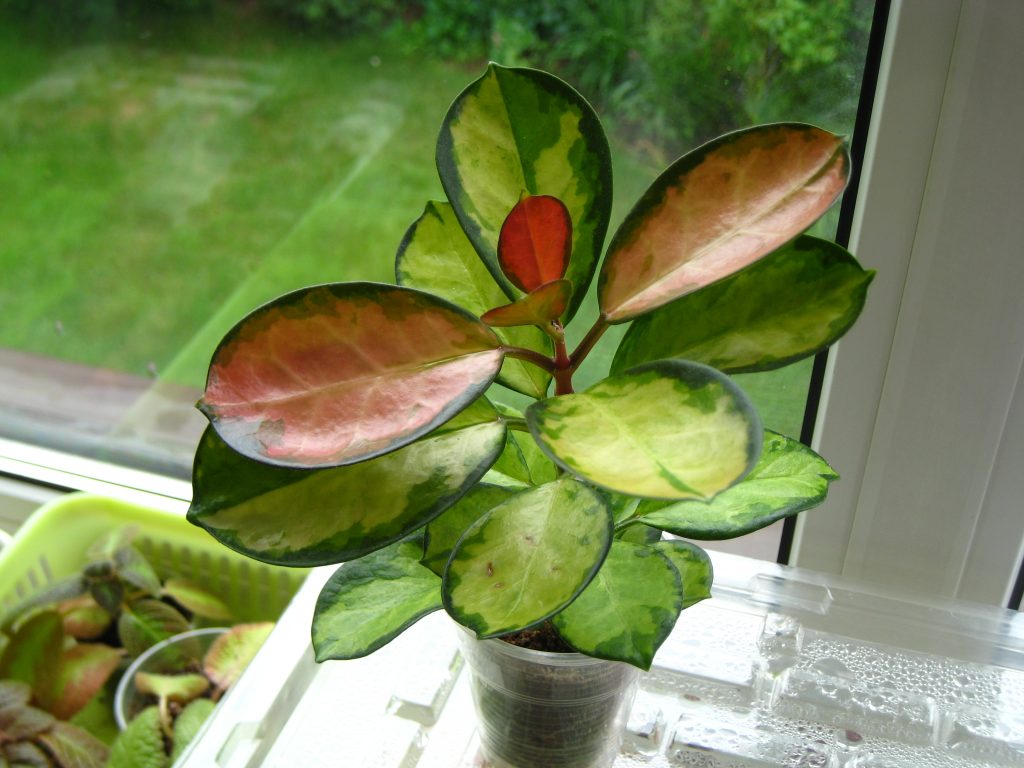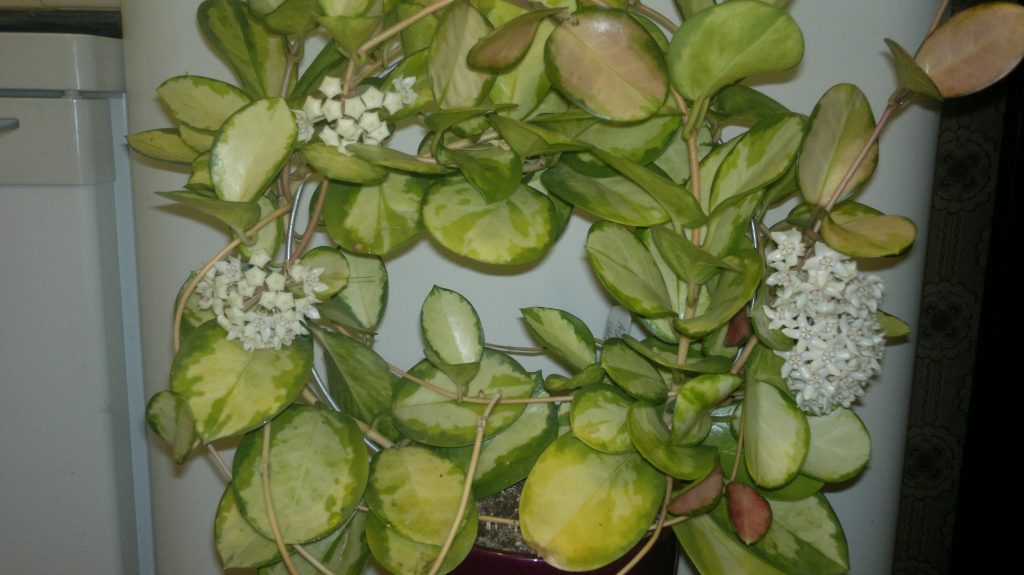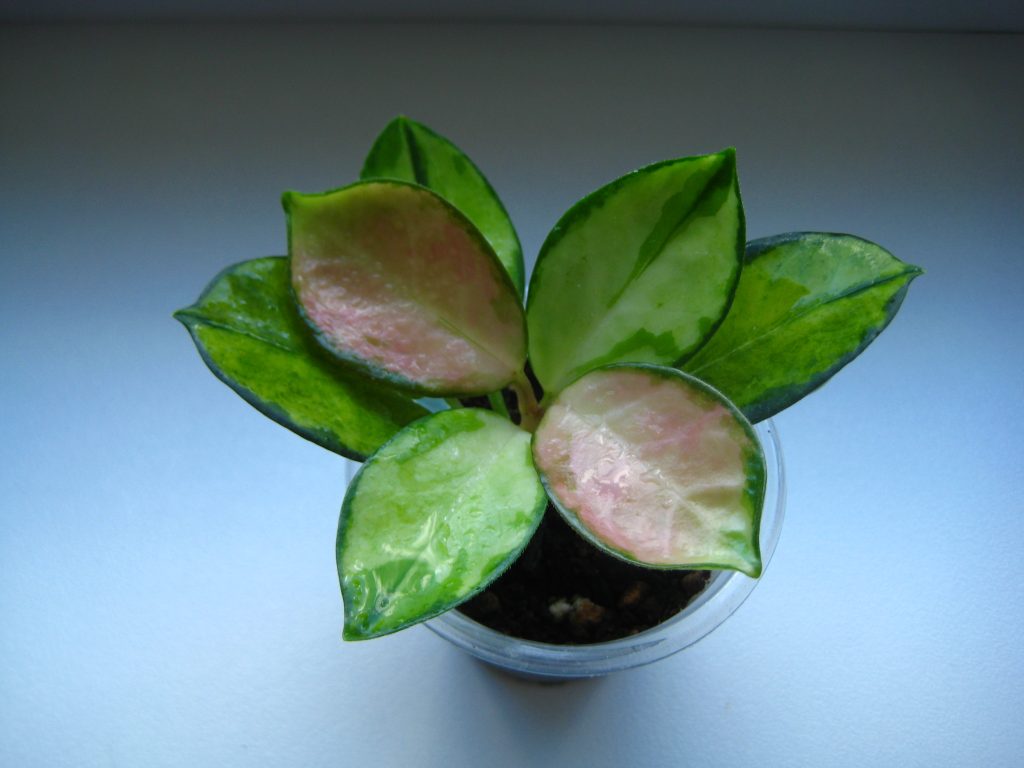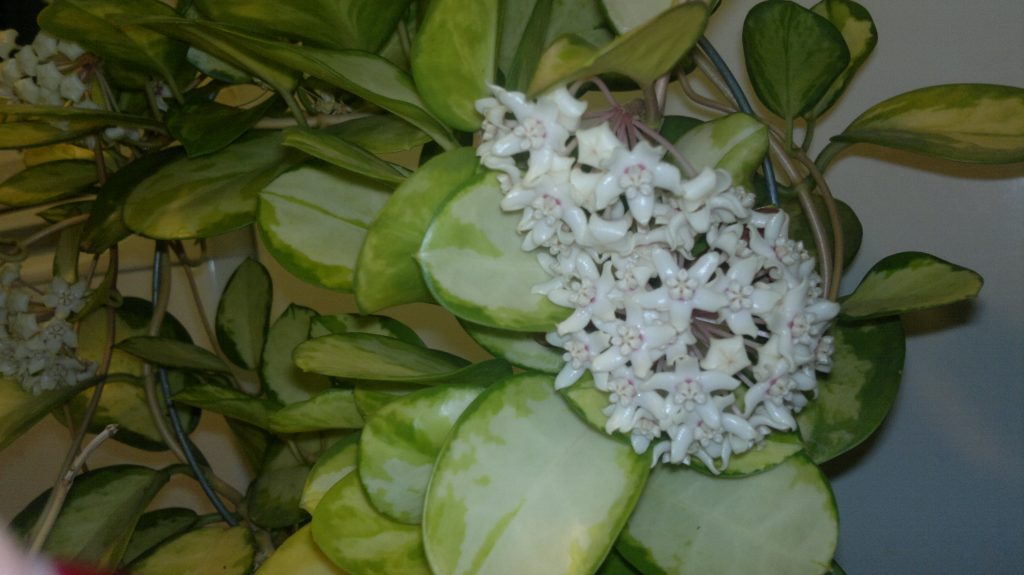Hoya Lisa Australis - all about caring for this beauty
Hoya Australi Lizas, or South, was found by scientists Solender and Banks on the Australian coast. Later, this species was discovered on the islands of Fiji and Samoa, in South Asia. The plant is very popular in home cultivation due to its decorative flowering, unpretentiousness and easy care.

Hoya australis lisa
Plant description
Lisa Australis is a vine from the Lastovnev family, which in nature reaches 7-10 m. Botanical name is Hoya australis.
At home, it grows up to 2 m. Hoya belongs to climbing plants, but branches little. Shoots lignify with age, so the flower is not grown in an ampelous way, but is tied to a high support, allowing it to braid and strive upward.
Leaves
Vine leaves grow on the stem in pairs. The leaf is oval, dense, glossy-waxy, with a pointed tip. In the center - light green with yellowish spots, at the edges - darker.
New leaves and shoots are reddish. The color of the foliage of the Hoya Lisa resembles the Hoya Albomarginate, but with one difference: the latter has a dark green color in the middle, and the border is light.
The appearance of new leaves is the miracle for which the growers love the variety so much. The combination of red and green on one plant looks very decorative.
Flowers
Small flowers with creamy white corollas are collected in lush spherical inflorescences (15-30 pcs.). The petals are firm, with wavy edges and a slightly curved tip. The middle is pink-crimson, the inner crown is white. Dense and glossy, like wax flowers, they look like delicate artificial jewelry.
When blooming, they exude sweetish nectar and a pleasant delicate aroma reminiscent of chrysanthemum.
Purchase and adaptation
South hoya can be bought in special greenhouses or from amateur flower growers via the Internet. Most often, cuttings are offered for cutting or already rooted. In any case, the plant must be carefully examined: it should not have foreign spots, damage, dry areas.

Hoya australis
At first, the hoyu is placed separately from other home flowers. 2-3 weeks are enough for quarantine. During this period, she is regularly examined, but they try not to disturb her.
Lianas provide diffused lighting, a temperature of 22-25 ° C and moderate watering as the upper layer of the substrate dries up. Transplanting and pruning the plant (or even just moving the pot) is not worth it.
Landing rules
Lisa Australis loves loose, neutral, well-drained soil. A soil mixture of leafy earth with the addition of peat, perlite, pieces of tree bark and coconut peel is suitable for her (all components must be disinfected). Compositions for orchids and succulents can be used as ready-made substrates.
For planting, choose a ceramic pot of the right size (for good flowering, the root system should be compactly placed in a container).You can also use a plastic flowerpot, but then the vine should be watered less often, since the moisture will evaporate more slowly.
Technology:
- Drainage from broken brick, expanded clay or small pebbles is laid at the bottom.
- The plant is rolled over together with a lump and a support is installed next to it.
- The substrate is poured into the free space and tamped.
- Hoya is poured with soft, lukewarm water.
The necessary conditions
Hoyka grows better in intense but diffused lighting. It must be shaded from direct rays. It responds well to artificial lighting, can grow in light partial shade.
The required humidity is slightly above average. The flower responds gratefully to spraying with lukewarm water and shower procedures (but not during flowering). A comfortable temperature for Lisa is from 20 ° C to 26 ° C, but not lower than 16 ° C.
Care
Flower care is not particularly difficult. The plant needs moderate watering and regular feeding. Transplant and prune it as needed.

Hoya lisa
Watering
Hoya is watered 1-2 times a week, provided that the upper part of the substrate has time to dry out. Use soft, settled water at room temperature. (To soften the water, you can add a little manganese.) In winter, watering is reduced, focusing on the condition of the soil.
Top dressing
The flower is fed twice a month with fertilizers for succulents. The dose prescribed on the package is halved by diluting with the indicated amount of water. The solution is applied after watering to a well-moistened soil.
Transfer
At first, the hoyku is transplanted annually, since the roots are actively growing. An adult flower does not really like to change its place of residence, therefore, a transplant is carried out every 3-5 years. As long as the roots fit in the flowerpot and stick out of the drainage holes, you can simply replace the top layer of the substrate.
Pruning
Sanitary pruning is carried out after flowering, trimming dry leaves and shoots. Long stems are shortened as needed.
In no case should you cut off dried peduncles, otherwise the flowers will not bloom in the next season.
Reproduction
Hoya Lisa Australis propagates by cuttings. To do this, cut off the shoots with two nodes and cut off the lower leaves. The cut site is treated with a root stimulator. Cuttings are rooted in water or in a moist substrate. In the first case, it is better to find a dark, opaque container or wrap the glass with foil.

Hoya australis photo
For successful rooting, a warm temperature of 22-25 ° C is required. To maintain a stable temperature, you can create a greenhouse effect by covering the plants with a bag or plastic cups.
If hoyks are planted in a substrate, it must be moistened as needed. Within 1-2 months, the cuttings take root. When new leaves grow on them, it is time to start transplanting into separate containers.
Diseases and pests
| Problem | Symptoms | Prophylaxis | Treatment |
| Mealybug | Cotton-like bloom, stunted growth and development. | Spraying, showering, airing, quarantine for new flowers. | Clean off plaque and insects with a brush in soapy water, wash with water, spray with tobacco or calendula infusion. For severe damage, apply Aktara, Fitoverm or Tanrek. |
| Aphid | Small light green bugs. Curling and drying of the leaves. | Cut off withered affected leaves, wash the plant with tar soap. In serious cases, use insecticides (Intavir, Fas, Karate). | |
| Whitefly | Larvae and flying insects. Honeydew in the form of plaque and black sooty mushroom. | Wash the hoya with alcohol and soap solution. Hang up sticky traps for winged pests, collect caterpillars by hand. Change the top layer of the substrate in the flowerpot. In case of serious damage, use Actellic or Confidor. | |
| Rot | Stopping growth, wilting, falling leaves. Thinning, darkening and softening of the stems. | Avoid waterlogging. Disinfect soil, pot, drainage, tools. | Remove damaged parts of the hoyka, treat with an antiseptic. Apply fungicides (Trichodermin, Mikosan, Topaz). Transplant the flower into a new substrate. |

